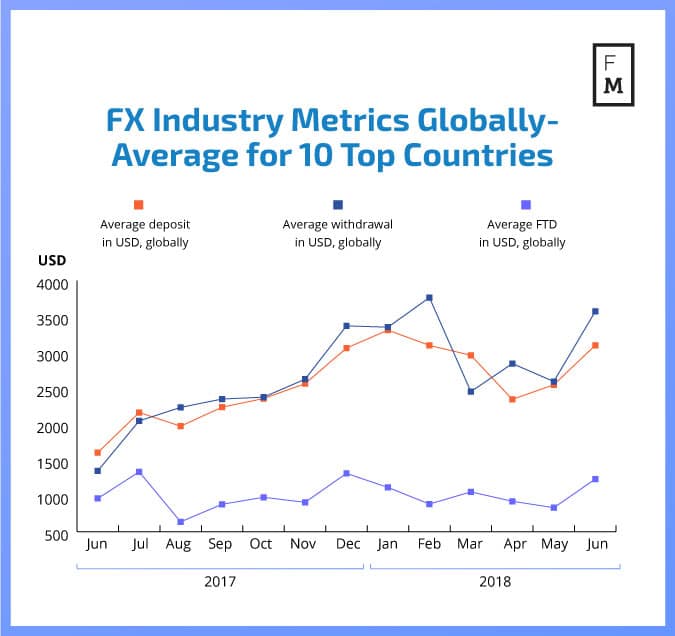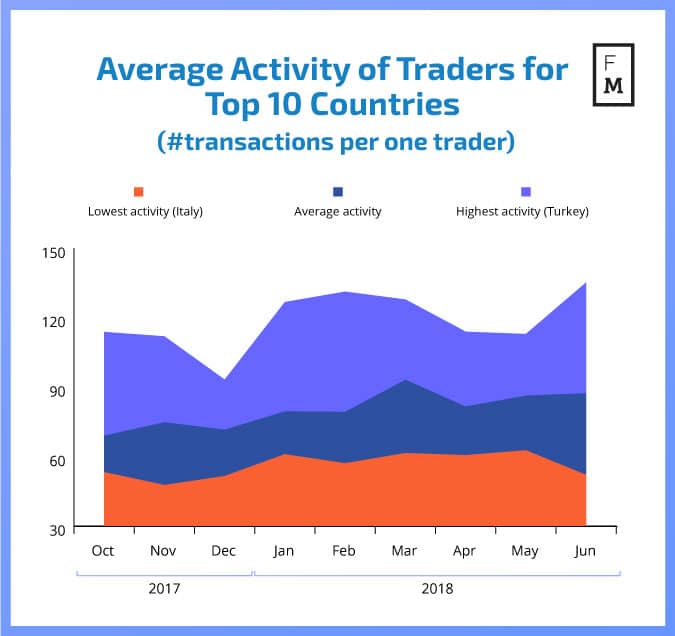Analysis: Hot Summer Does Not Stop FX Traders Investing in June
- Average deposit size grows again, despite summer break approaching

Right before the start of summer vacation, the retail FX industry registers an impressive recovery from the recent three-month-long weakness. As the latest analysis by Finance Magnates’ Intelligence Department of data from CPattern shows, in June the average deposit size grew back to levels over $3,500.

This is an interesting and to some extent surprising situation. Data for 2017 shows that the second half of last year was more active regarding the size of deposits. However, in 2017 the growth trend began around July and continued until the end of the year. Since this year, the growth trend is already emerging in June, it will be interesting to see how it evolves in the coming six months.

Among the Top 10 countries with the highest deposit size, Germany lead the ranks. With $4,831.6 deposited on average to their accounts, German traders were noticeably ahead of Australians, where the average deposit size in June was $4,046.8. Most surprising, however, is the third position held by Brazil. An average deposit of $3,935.4 indicates growing activity in the country where an official FX/CFD retail trading industry barely exists.

When it comes to the average number of transactions per trader, June saw some minor growth. Turkey registered the highest activity with an average of 135.2 transactions per trader. Out of the top 10 countries in terms of activity, Italy held the last place with an average of 52.2 transactions per trader. As usual, Chinese traders were also active but this time a little further behind in 4th place.
This is the latest publication from the FM Indices – a new cross-industry benchmark. In today’s business world, Big Data Big Data Big data refers to the collection of data that is too complex and too large for processing by standard database tools. There is no specific quantity of data, which is set as a minimum level to be considered Big data. Image the data collected on global credit card transactions. Many governments used Big data analysis to study the recent pandemic spread. The term Big data was first introduced in 1980 by Charles Tilly.The term Big data was primarily used in computer science, statistics, and econome Big data refers to the collection of data that is too complex and too large for processing by standard database tools. There is no specific quantity of data, which is set as a minimum level to be considered Big data. Image the data collected on global credit card transactions. Many governments used Big data analysis to study the recent pandemic spread. The term Big data was first introduced in 1980 by Charles Tilly.The term Big data was primarily used in computer science, statistics, and econome Read this Term analysis and access to objective information sources are crucial to success. Unfortunately, until now, it has been very difficult and costly, if possible at all, to find any reliable benchmarks for operations in social, FX, binary options, and CFDs trading.
For this reason, the Finance Magnates Intelligence Department has launched a new project, creating a set of indices encompassing various aspects of the Online Trading Online Trading Online trading represents the trading of fiat currencies, digital currencies, commodities, stocks and indices, where traders and investors intend to make a profit, via the purchase or sale of the aforementioned products. This is done through an electronic network, made accessible by brokers in the form of an online trading platform or hub.Online trading continues to see a rapid growth year on year, due to a number of reasons. Firstly, the number of brokers offering their services, with more mone Online trading represents the trading of fiat currencies, digital currencies, commodities, stocks and indices, where traders and investors intend to make a profit, via the purchase or sale of the aforementioned products. This is done through an electronic network, made accessible by brokers in the form of an online trading platform or hub.Online trading continues to see a rapid growth year on year, due to a number of reasons. Firstly, the number of brokers offering their services, with more mone Read this Term industry. These indices will provide you with unique data points gathered by our analysts, that will serve as a valuable knowledge base for your decision making.
Right before the start of summer vacation, the retail FX industry registers an impressive recovery from the recent three-month-long weakness. As the latest analysis by Finance Magnates’ Intelligence Department of data from CPattern shows, in June the average deposit size grew back to levels over $3,500.

This is an interesting and to some extent surprising situation. Data for 2017 shows that the second half of last year was more active regarding the size of deposits. However, in 2017 the growth trend began around July and continued until the end of the year. Since this year, the growth trend is already emerging in June, it will be interesting to see how it evolves in the coming six months.

Among the Top 10 countries with the highest deposit size, Germany lead the ranks. With $4,831.6 deposited on average to their accounts, German traders were noticeably ahead of Australians, where the average deposit size in June was $4,046.8. Most surprising, however, is the third position held by Brazil. An average deposit of $3,935.4 indicates growing activity in the country where an official FX/CFD retail trading industry barely exists.

When it comes to the average number of transactions per trader, June saw some minor growth. Turkey registered the highest activity with an average of 135.2 transactions per trader. Out of the top 10 countries in terms of activity, Italy held the last place with an average of 52.2 transactions per trader. As usual, Chinese traders were also active but this time a little further behind in 4th place.
This is the latest publication from the FM Indices – a new cross-industry benchmark. In today’s business world, Big Data Big Data Big data refers to the collection of data that is too complex and too large for processing by standard database tools. There is no specific quantity of data, which is set as a minimum level to be considered Big data. Image the data collected on global credit card transactions. Many governments used Big data analysis to study the recent pandemic spread. The term Big data was first introduced in 1980 by Charles Tilly.The term Big data was primarily used in computer science, statistics, and econome Big data refers to the collection of data that is too complex and too large for processing by standard database tools. There is no specific quantity of data, which is set as a minimum level to be considered Big data. Image the data collected on global credit card transactions. Many governments used Big data analysis to study the recent pandemic spread. The term Big data was first introduced in 1980 by Charles Tilly.The term Big data was primarily used in computer science, statistics, and econome Read this Term analysis and access to objective information sources are crucial to success. Unfortunately, until now, it has been very difficult and costly, if possible at all, to find any reliable benchmarks for operations in social, FX, binary options, and CFDs trading.
For this reason, the Finance Magnates Intelligence Department has launched a new project, creating a set of indices encompassing various aspects of the Online Trading Online Trading Online trading represents the trading of fiat currencies, digital currencies, commodities, stocks and indices, where traders and investors intend to make a profit, via the purchase or sale of the aforementioned products. This is done through an electronic network, made accessible by brokers in the form of an online trading platform or hub.Online trading continues to see a rapid growth year on year, due to a number of reasons. Firstly, the number of brokers offering their services, with more mone Online trading represents the trading of fiat currencies, digital currencies, commodities, stocks and indices, where traders and investors intend to make a profit, via the purchase or sale of the aforementioned products. This is done through an electronic network, made accessible by brokers in the form of an online trading platform or hub.Online trading continues to see a rapid growth year on year, due to a number of reasons. Firstly, the number of brokers offering their services, with more mone Read this Term industry. These indices will provide you with unique data points gathered by our analysts, that will serve as a valuable knowledge base for your decision making.
